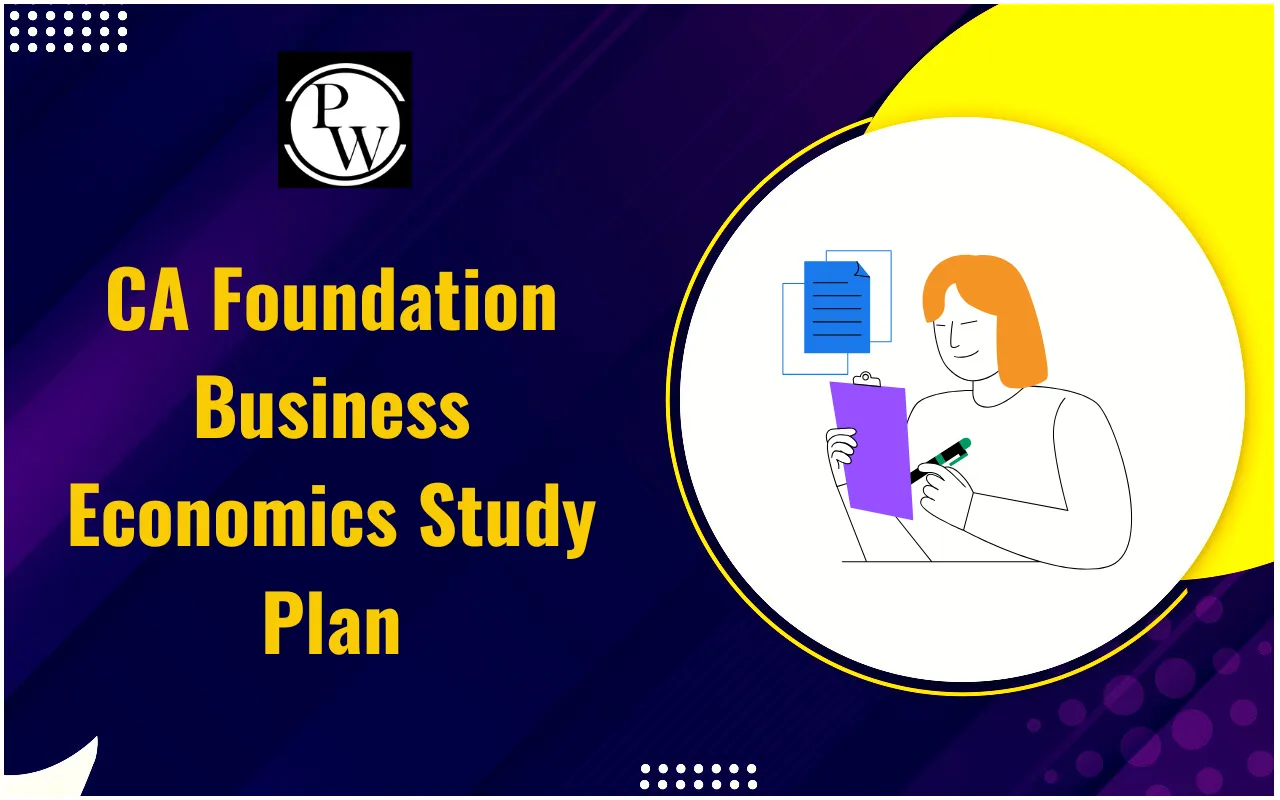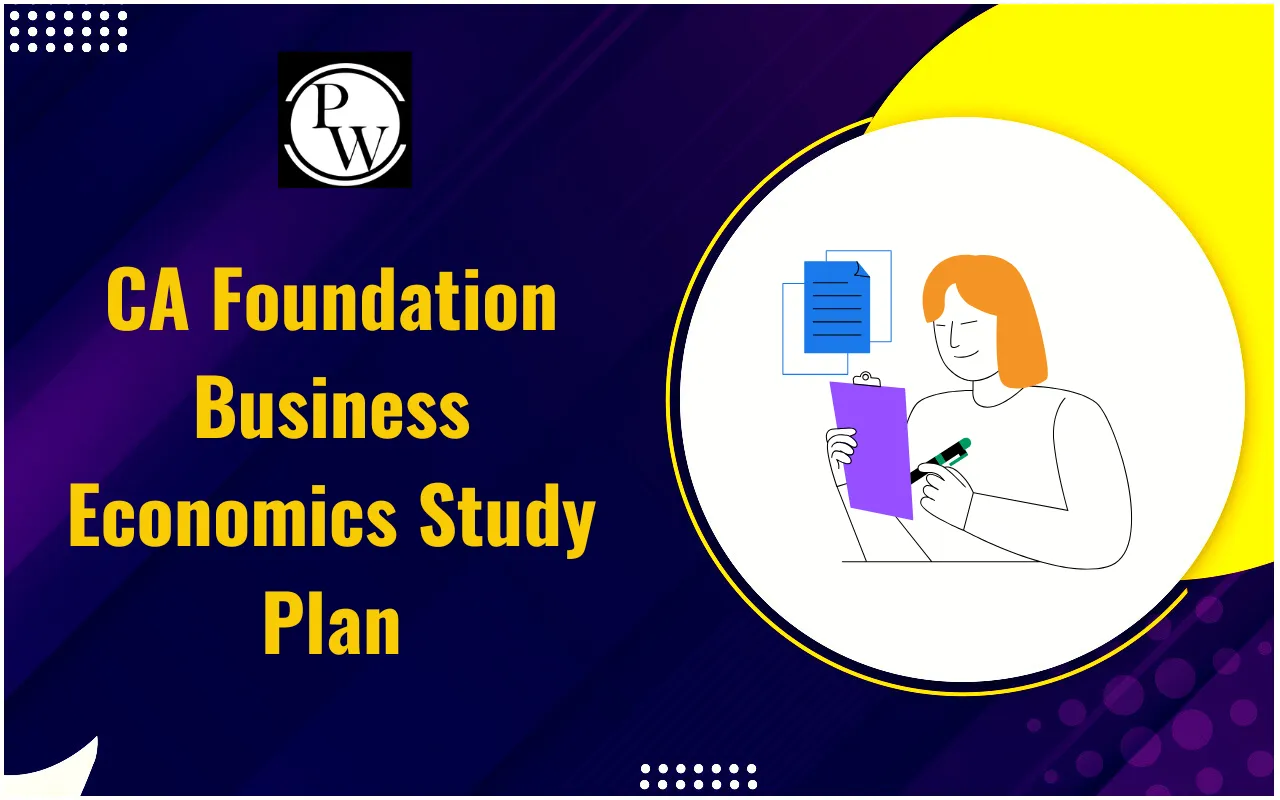

Preparing for the CA Foundation exams is challenging. Among all the papers, Business Economics holds a significant place due to its weightage and application-oriented nature. For students aiming to crack Business Economics with flying colors, having a well-structured CA Foundation Business Economics Study Plan for the last 90 days is crucial. Check below the preparation strategies, chapter-wise importance, revision plans, and last-minute tips to ensure your preparation is result-oriented.
CA Foundation Business Economics Study Plan for Last 90 Days
To effectively utilize the last 90 days before the CA Foundation exam, it is important to follow a structured day-wise study plan. The table below breaks down chapters, focus areas and key activities to help you cover all topics systematically and revise efficiently.
|
CA Foundation Business Economics Study Plan for Last 90 Days |
||||
|
Week |
Days |
Focus Area / Chapter |
Key Activities / Preparation Strategy |
Notes / Tips |
|
1 |
1–5 |
Nature & Scope of Business Economics |
Read concepts, understand objectives and scope, study price mechanism |
Make short notes & diagrams for quick revision |
|
1–2 |
6–12 |
Theory of Demand |
Law of Demand, Elasticity, Consumer Behaviour |
Solve numerical problems, practice graphs |
|
2 |
13–18 |
Theory of Supply |
Supply analysis, practical examples |
Revise with Demand concepts for clarity |
|
3 |
19–24 |
Theory of Production & Cost |
Production functions, cost curves, law of variable proportion |
Practice numerical problems & diagrams multiple times |
|
4 |
25–30 |
Price Determination in Different Markets |
Market types, price & output determination, perfect & imperfect competition |
Use charts for characteristics of each market |
|
5 |
31–33 |
Business Cycles |
Phases, impact on businesses & economy |
Link with real-world examples like inflation & recession |
|
5 |
34–36 |
Determination of National Income |
National income accounting, Keynesian theory |
Revise numerical problems, practice questions |
|
6 |
37–42 |
Public Finance |
Fiscal functions, budget process, government intervention, fiscal policy |
Make a formula sheet for revenue & expenditure |
|
7 |
43–47 |
Money Market |
Money supply & demand, monetary policy |
Solve previous year questions |
|
8 |
48–52 |
International Trade |
Trade theories, policy instruments, exchange rate, trade negotiations |
Use diagrams for trade flows & policies |
|
9 |
53–56 |
Indian Economy |
Key features, economic challenges, current updates |
Revise notes & keep points short for last-minute recall |
|
10 |
57–63 |
Revision of High-Weightage Chapters |
Demand & Supply, Production & Cost, Market Structures, Public Finance |
Take chapter-wise tests |
|
11 |
64–70 |
Mock Tests & Previous Year Questions |
Full-syllabus practice tests |
Analyze mistakes & maintain error log |
|
12 |
71–75 |
Weak Areas Focus |
Revise topics with frequent mistakes |
Practice numerical & diagram-based questions |
|
12 |
76–80 |
Final Revision |
Go through short notes, formulas, diagrams |
Focus on speed & accuracy |
|
12 |
81–85 |
Last-Minute Practice |
Attempt 2–3 full-length mock tests |
Simulate exam conditions |
|
12 |
86–90 |
Final Touch & Relaxation |
Quick revision of high-weightage chapters |
Stay calm, avoid learning new topics |
Why Does 90-Day Study Plan Matters?
The last 90 days before the CA Foundation exam are the most critical. By this time, you should have already covered the basics of all subjects. What remains is consolidation, revision, practice and sharpening your problem-solving skills. For Business Economics this period is ideal to focus on key topics, solve past year questions, practice numerical problems and fine-tune your understanding of concepts.
CA Foundation 3 months study plan is designed to balance learning, revision and practice. Following a structured timetable prevents last-minute stress, ensures coverage of all chapters, and improves your confidence for the exam.
CA Foundation Business Economics Preparation Strategy
A solid CA Foundation Business Economics preparation strategy involves three main components:
-
Conceptual Clarity – Understanding fundamental concepts like demand-supply, production, cost, market structures, fiscal and monetary policy is crucial. Avoid rote memorization focus on understanding the why behind each concept.
-
Practice-Oriented Learning – Solve numerical problems, attempt case studies, and practice graphs. This builds analytical skills and prepares you for application-based questions.
-
Regular Revision – Frequent revision helps retain concepts and reduces mistakes during the exam. Combine quick notes, charts and formulas for faster recall.
CA Foundation Business Economics Important Topics
Understanding CA Foundation Business Economics chapter-wise weightage helps you allocate time effectively in your last 90 days. Here is a breakdown based on past exam trends:
|
CA Foundation Business Economics Important Topics |
||
|
Chapter |
Weightage |
Important Topics |
|
Nature & Scope of Business Economics |
3-4 marks |
Introduction, Basic Problems of an Economy, Price Mechanism |
|
Theory of Demand and Supply |
10-12 marks |
Law of Demand, Elasticity of Demand, Consumer Behaviour, Supply Analysis |
|
Theory of Production and Cost |
8-10 marks |
Production Functions, Cost Curves, Law of Variable Proportion |
|
Price Determination in Different Markets |
12-15 marks |
Market Types, Price & Output Determination, Perfect & Imperfect Competition |
|
Business Cycles |
4-5 marks |
Phases of Business Cycle, Impact on Economy |
|
Determination of National Income |
6-8 marks |
National Income Accounting, Keynesian Theory |
|
Public Finance |
10-12 marks |
Fiscal Functions, Budgeting, Fiscal Policy, Market Failure |
|
Money Market |
5-7 marks |
Money Supply & Demand, Monetary Policy |
|
International Trade |
5-6 marks |
Trade Theories, Policy Instruments, Exchange Rate |
|
Indian Economy |
3-4 marks |
Key Features, Economic Challenges |
CA Foundation Business Economics Revision Plan
A well-planned revision plan is important in the last 90 days:
-
Daily Revision: Spend at least 1–2 hours revising previously studied chapters.
-
Weekly Full Syllabus Revision: Every week, revise all chapters to reinforce memory.
-
Formula & Graph Revision: Keep a separate sheet for all formulas, graphs, and key definitions.
-
Past Year Questions: Solve questions from the last 5 years to understand the exam pattern.
-
Mock Tests: Take regular mock tests to improve time management and accuracy.
CA Foundation Business Economics Last-Minute Tips
As the exam approaches, the last few days are all about revision, practice and smart strategies rather than learning new topics. Here are some effective tips to maximize your score in Business Economics:
-
Prioritize High-Weightage Chapters: Focus on Demand & Supply, Market Structures, Production & Cost, and Public Finance.
-
Solve Previous Year Papers: Familiarize yourself with question patterns and frequently asked questions.
-
Use Short Notes: For quick recall before exams.
-
Practice Graphs & Numerical Problems: Most marks come from application-based questions.
-
Time Management: Practice solving the paper within the exam time to improve speed and accuracy.
How to Prepare Business Economics for CA Foundation
To prepare Business Economics for CA Foundation effectively:
-
Understand the concepts clearly rather than rote learning.
-
Link theory with real-life examples for better understanding.
-
Maintain a formula sheet and diagram list for quick reference.
-
Allocate specific time slots for practice, revision, and mock tests.
-
Regularly assess yourself through chapter-wise and full-syllabus tests.
Sample CA Foundation Last 90 Days Timetable (Business Economics Focus)
To maximize your score in Business Economics, it’s important to follow a well-structured 90-day timetable that balances learning, revision, and practice. Here’s a week-wise breakdown:
|
Sample CA Foundation Last 90 Days Timetable (Business Economics Focus) |
||
|
Week |
Focus Area |
Key Activities |
|
Week 1–2 |
Nature & Scope + Demand |
Read concepts, practice graphs, solve numerical problems |
|
Week 3–4 |
Supply + Consumer Behaviour |
Apply examples, solve past questions, revise elasticity |
|
Week 5–6 |
Production & Cost |
Understand cost curves, production functions, solve numerical problems |
|
Week 7 |
Market Structures |
Learn characteristics, pricing strategies, solve numerical questions |
|
Week 8 |
Business Cycles + National Income |
Conceptual clarity, link to real-life examples |
|
Week 9 |
Public Finance |
Fiscal functions, budget, government intervention, practice questions |
|
Week 10 |
Money Market + International Trade |
Learn money supply & demand, trade policies, solve past papers |
|
Week 11 |
Indian Economy + Revision |
Revise high-weightage topics, solve mock tests |
|
Week 12 |
Final Revision + Mock Tests |
Full syllabus revision, practice exams, fine-tune weak areas |
